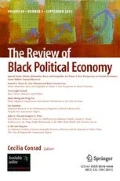Abstract
The high unemployment rate of black high school graduates can create the perception that a diploma is of little value and encourage dropping-out of school. Black youth who do drop out are less employable and further push up the black youth unemployment rate. This raises a question: Is the high dropout rate of black youth due to their high unemployment rate or is their high unemployment rate due to their high dropout rate? A study of this question using the definition of Granger-causality finds that it is the high unemployment rate which causes the high dropout rate rather than the opposite.
Similar content being viewed by others
Notes
Richard B. Freeman and Harry J. Hozer (eds.),The Black Youth Employment Crisis (Chicago: University of Chicago, 1986).
Robert B. Hill and Regina Nixon,Youth Employment in American Industry (New Brunswick, New Jersey: Transaction Books, 1984), pp. 39–40.
John E Cogan, “The Decline in Black Teenage Employment: 1950–70,”American Economic Review 72 (September 1982), pp. 621–638.
See, for example, Lawrence G. Felice, “Black Student Dropout Behavior: Disengagement From School, Rejection and Racial Discrimination,”The Journal of Negro Education 50 (Fall 1981), pp. 415–424.; Michael Fine and Pearl Rosenberg,“ Dropping Out of High School: The Ideology of School and Work,”Journal of Education 165 (Summer 1983), pp. 257-272; Ronald L. Richardson and S. Craig Gerlach,“ Black Dropouts: A Study of Significant Factors Contributing to a Black Student’s Decision,”Urban Education 14 (January 1980), pp. 489–494.
Beverly Duncan, “Dropouts and the Unemployed,”Journal of Political Economy 72 (April 1965), pp. 121–134.
C.W.J. Granger, “Investigating Causal Relations by Econometric Models and Cross-Spectral Methods,”Econometrica 37 (July 1969), pp. 424–438.
The full set of figures for 1960-84 is available on request from the authors and is on file with the editor of the journal. The sources of these data are as follows: 1960–80,Labor Force Statistics Derived from the Current Population Survey: A Databook Volume 1, Bulletin 2096, September 1982, Table 3, pp. 767–774; 1981-83,Handbook of Labor Statistics, Bulletin 2217, June 1985, Table 60, p. 163, both publications of the U.S. Department of Labor, Bureau of Labor Statistics; 1984, unpublished statistics provided by the Bureau of Labor Statistics. The data for 1960 to 1976 include blacks and other non-whites and for 1977 to 1984 blacks only. For simplicity we refer to blacks for the full period, 1960–84.
Michael L. Wachter, “The Dimensions and Complexities of the Youth Unemployment Problem,” inYouth Employment and Public Policy edited by Bernard E. Anderson and Isabel V. Sawhill (New York: Prentice-Hall, 1980), pp. 33–63.
Granger,, and Christopher Sims,“ Money, Income and Causality,”American Economic Review 62 (September 1972), pp. 540-552.
Christopher Sims, “Macroeconomics and Reality,”Econometrica 48 (January 1980), pp. 1–48.
Cheng Hsiao, “Autoregressive Modeling of Canadian Money and Income Data,”Journal of the American Statistical Association 74 (September 1979), pp. 533–60 and Cheng Hsiao,“ Autoregressive Modelling and Money-Income Causality Detection,”Journal of Monetary Economics 8 (January 1981), pp. 85–106.
The FPE procedure has been widely used in the literature. See Hizotogu Akaike, “Statistical Prediction Identification,”Annals of the Institute of Statistical Mathematics 21 (1969), pp. 203–217; Hizotogu Akaike“ Fitting Autoregressions for Prediction,”Annals of the Institute of Statistical Mathematics 21 (1969), pp. 243–247; James S. Fackler,“ An Empirical Analysis of the Markets for Goods, Money, and Credit,”Journal of Money, Credit, and Banking 17 (February 1985), pp. 28–42; James Lesage and Michael Magura,“ Econometric Modeling of Interregional Labor Market Linkages,”Journal of Regional Science, vol. 26, no. 3 (1986), pp. 567–577.
See, for example, Robert S. Pindyck and Daniel Rubinfeld,Econometric Models and Economic Forecasts (New York: McGraw-Hill, 1981), pp. 331–34.
Model adequacy was checked by lagging the residuals of each equation on six own-lags and performing joint F-tests. Also Durbin’s cumulated periodogram was used. (See J. Durbin, “Tests for Serial Correlation in Regression Analysis Based on the Periodogram of Least Squares Residuals,”Biometrika 56 (1970), pp. 1–16) Neither test permitted the rejection of the hypothesis that the residuals were not significantly different from white noise.
Sims, 1980.
See, for example, Sims, 1980.
Ibid.
About this article
Cite this article
Magura, M., Shapiro, E. The black dropout rate and the black youth unemployment rate: A Granger-causal analysis. Rev Black Polit Econ 15, 56–67 (1987). https://doi.org/10.1007/BF02903992
Issue Date:
DOI: https://doi.org/10.1007/BF02903992




